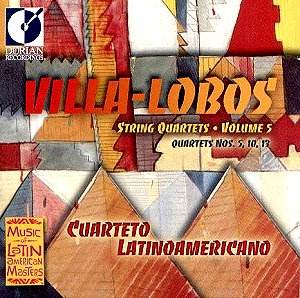Five down, one to go. The Seventeen Quartets
of Villa-Lobos – he didn’t live to complete the Eighteenth – are
a formidable corpus of work. And they’re exciting too, rhythmically
dynamic, instrumentally colourful, the later ones tinged with
moments of creative atonality. In six volumes we have here a same-as-before
mixture of early-ish and late, except Villa-Lobos was not really
a same-as-before kind of composer. I love the opening Andantino
of the Fifth Quartet so much I could get in there and eat it.
Grace, humour, a multipartite structure, deliciously placed pizzicati
and a songful delicacy based on a children’s song – it has it
all. Those familiar displaced accents make their telling presence
felt as ever with him. Resist this and, frankly, you have a hard
heart indeed. In the fast second movement he makes great use of
shuddering glissandi and this openly polyrhythmic movement sways
in the breeze of his imagination with infectious mastery. The
finale is a moto perpetuo, again based on a song and once again
it sways and shimmers and then drives with brilliant abandon with
the first violinist earning his keep with some virtuosic passages.
Dating from just after the end of the Second
War the Tenth, in the regulation four movements, opens in strongly
imitative style with a splintering coda that telescopes the material
into compressed form. The Adagio is quite thickly scored and in
fact rather more concentrated than one otherwise finds in Villa-Lobos’s
Quartet Adagios or Andantes. There’s plenty of bustle though in
the Scherzo, animated by lashings of ostinati and in the finale
there’s free use of dissonance as a creative and colouristic,
no less than a musical, device – swinging rhythm, fugato, pizzicato
underpinning, and once more another example of his splendidly
theatrical and supercharged codas. The final work in the disc,
the Thirteenth shows how well he had absorbed elements of atonality
in his later music. The writing is predominantly intervallic and
much is unison playing with imitative counterpoint. The writing
manages to be flexible and also relaxed despite these rigorous
sounding procedures. Then we have a sparky, frisky scherzo – complete
with little eruptive sforzati – all deliciously compact. The heart
of the work is the long Adagio and this is in his best long-breathed
tradition, sustained and suffused in yearning and nostalgia. Simplicity
of utterance is accompanied by apposite technical means, as in
the best music. The first fiddle has an intensely expressive part
over ostinato accompaniment and throughout there’s a sense of
the most affectionate depth. To end there is a tumultuous Allegro
– full of slowing down and rhythmic high jinks.
Five volumes reviewed so far and five recommendations.
The Latin American Quartet maintains a high standard throughout;
elsewhere their tempi may be fractionally under the mark but not
here. They are acute and sensitive guides to this literature and
they play with imagination and affection.
Jonathan Woolf
Other
reviews
Volume
1
Volume
2
Volume
3
Volume
4
Volume
5
Volume
6
